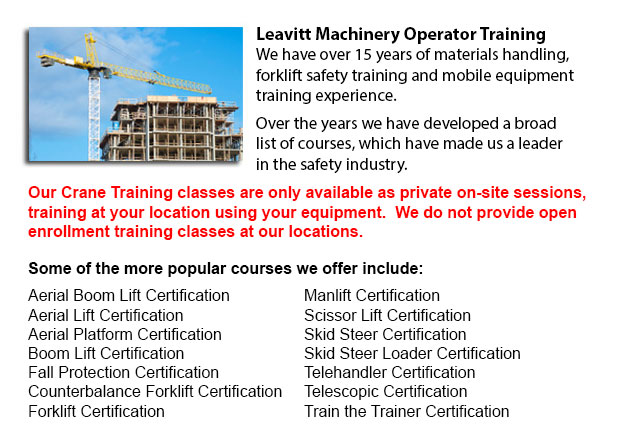
St Catharines Crane Certification - The Crane Certification Program covers the industry suggested content which would teach the safe and efficient operation of cranes. The individual will train in the following: how to identify cranes and their component parts; pre-operational, operational and post-operating requirements; how to determine overall lift capacity; rigging components and inspection/rejection criteria; and needs particular to the work location where the people training would be operating.
The requirements that must be performed prior to operating a crane includes assigning authority for the pre-operational check; carrying out the sequential pre-operational check based on the specifications certified by a professional engineer or manufacturer's specifications; checking the log book for comments; checking the work place for obstacles and hazards; checking hooks, chains, cables, safety latches and crane movement; ensuring the right functioning of operational controls; and learning how to ensure the disconnect switch/isolator of the crane is correctly functioning.
Operational requirements comprise identifying roles and responsibilities, and determining the need for a formal lift plan. Trainees would be taught how to carry out a danger assessment related to environmental situations, physical situations and employees. Subject matter consists of determining when to seek competent support, the destination of loads and the safest route, and load weight and centre of gravity.
It is essential for individuals training to be able to identify an over-capacity lift, pick proper rigging equipment, be aware of load limitations, and determine a safe spot from which to operate. Trainees would review both universal and site-specific crane signals for lifts, and techniques for traveling, lifting and loading. Appropriate maintenance habits will be covered.
The person training will undergo an examination to test their understanding of emergency response techniques for various circumstances, particularly electrical or mechanical failures. They will be asked to describe parking and shut down procedures for security and safety, to follow lock out and tagging procedures, and to explain the reason why near misses are recorded and reported to the appropriate person. Log book records must be maintained.
The person training will learn the particulars of rigging, and be taught the responsibility and authority for rigging. They would learn to identify the various types of rigging, the load capacity ratings and storage procedures.
The requirements after operation of the crane would be taught as well, learning to enter the defects and deficiencies; and to log the history of maintenance and service records, in accordance to the state, provincial and federal codes requirements.
What's more, we include site-specific needs to be able to meet the employers requirements into our crane certification training program.
-
St Catharines Heavy Equipment Training Schools
St Catharines Heavy Equipment Training Schools - When selecting an operator training course, there are a lot of heavy equipment training schools to choose from. To be able to ascertain the qualifications you will attain, it is very important to explo... More -
St Catharines Heavy Equipment Operator Training
St Catharines Heavy Equipment Operator Training - Heavy equipment operator training facilities that offer quality standards within the business, offering field performance work and additional machine training are really sought after training features... More -
St Catharines Forklift Training Programs
St Catharines Forklift Training Programs - Are you looking for work as a driver of a forklift? Our regulatory-compliant mobile equipment operator training offers instruction in kinds of forklifts, pre-shift check, fuel kinds and handling of fuels, an... More -
St Catharines Heavy Equipment License
St Catharines Heavy Equipment License - A heavy equipment license can be obtained by taking a certification and preparation course at a private training school or a vocational school. This license would qualify you to operate various types of heavy e... More -
St Catharines Overhead Crane Safety Training
St Catharines Overhead Crane Safety Training - Overhead crane safety training equips operators with skills and knowledge regarding crane safety precautions, accident avoidance, materials handling, and equipment and stock protection. Trainees will lea... More -
St Catharines Scissor Lift Training
St Catharines Scissor Lift Training - Scissor lifts should be operated proficiently to be able to protect the safety of the equipment and the wellbeing of others within the workplace. Operators who are skilled are trained to drive the specific type o... More -
St Catharines Telescopic Training
St Catharines Telescopic Training - Telescopic Handlers are a kind of forklift, normally known as telehandlers. This machine has been increasing in popularity due to its greater lift heights and its versatility. It is often preferred over the convent... More -
St Catharines Boom Lift Certification
St Catharines Boom Lift Certification - Utilizing elevated work platforms allow for maintenance operations and work to be carried out at elevated work heights which were otherwise unreachable. Boom Lift Certification Training educates workers about t... More

Forklift Certification St Catharines
TOLL FREE: 1-888-254-6157
St Catharines, Ontario
forkliftcertificationstcatharines.com/
Email Us
About Us


